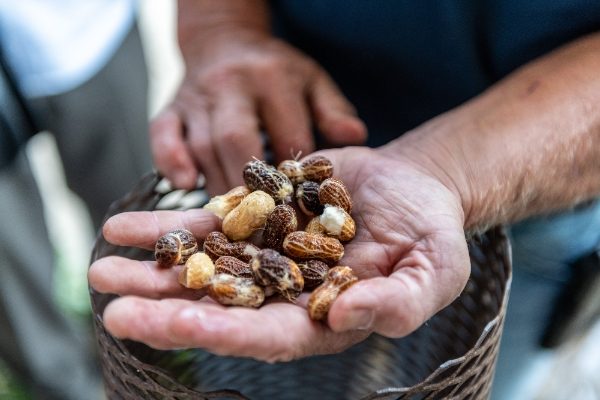Peanuts are high in fat, for sure, but here I share 5 surprisingly healthy facts about peanuts, live from a peanut farm! Did you know that peanuts have the smallest carbon footprint of any nut? Read on to find out more…
I am still buzzing from my tour of the Georgian peanut farms, kindly hosted by the government-funded American Peanut Council. They’ve asked me to write a blog about the trip so here’s my honest review of the facts I learned on health benefits of peanuts…as well as some highlights and fab photos including this prized pic with the world’s most famous peanut farmer, no less than President Jimmy Carter.
Fact 1: Peanuts are not a nut; they’re actually a legume
Unlike tree nuts, peanuts grow in the ground (think “groundnuts”). Open one up and you’ll see that it looks very much like a bean, with two halves and an embryo inside. So, like legumes it gives you protein and fibre, and being a nut, it carries healthy fats (80% of a peanut is unsaturated fat) and a host of nutrients such as vitamin B2, which is needed for energy yielding metabolism as well as magnesium, needed for bone health.

Olly from Living BBQ captures peanuts in the ground
Fact 2: Peanuts have the smallest carbon footprint of any nut
My learning from Dan Ward, Chairman of the National Peanut Board, was fascinating: “It takes only 4.7 gallons of water to grow an ounce of peanuts, but you need more than 80 gallons to grow an ounce of almonds”. Since peanuts are a legume and produce their own nitrogen, you need very little nitrogen for peanut growth, thus minimising the grey water footprint.
Everything from the roots to the hulls are used up, for example peanut hay is used as feed for cattle and the hulls can be made into pellets and used as a renewable source of biofuel. And farmers have already started to use technological advancements which will hopefully help peanuts further reduce their environmental impact in the future.

A mountain of peanuts in their shells
Fact 3: Peanuts contain Resveratrol found in red wine and more phytosterols than olive oil
Phytosterols in peanuts have been associated with lower risk of cancer and heart disease in many studies. Research suggests that the powerful antioxidant resveratrol may stop cancer cells from growing and it has also been associated with reduced risks of heart disease. Further, resveratrol appears to protect against neuropathy and blindness in diabetes. Peanut oil contains 38-43% more phytosterols than olive oil.

Peanuts in their shells come in different shapes and sizes
Fact 4: Peanut butter has no butter in it
Peanuts and peanut butter are naturally cholesterol free. Although they’re high in calories, they are surprisingly nutritious.
My trip to Tara peanut butter factory was insightful:
- Peanut butter by law must be 90% peanuts.
- The shells are used for animal feed.
- They’ve experimented a process that includes the fibrous red skin from peanuts but customers rejected it as it looked like specks of black pepper. Such a shame!
- It takes about 540 peanuts to make a 12-ounce jar of peanut butter.
Apparently peanut butter was originally made for people with no teeth. (For me the crunchier the better). Check out my crunchy peanut satay dip.

Influencers from UK, Holland and Germany learn about health benefits of peanuts with the Tara Foods Team
Influencers from UK, the Netherlands and Germany with the Tara Foods Team
Fact 5: Peanuts can help protect brain cells
After breakfast with President Jimmy Carter (thought I’d drop that in again), Dr Samara Sterling presented a whistle-stop tour of the research on peanuts. One intriguing 2018 study on 4822 older adults who were examined over 15 years suggested that eating only 10 peanuts a day was associated with a 40% lower risk of poor cognitive function. So, another great reason to include peanuts in your diet.

Samara shares her research on why peanuts are healthy.
In my practice, I advise people to eat a handful (around 30g) a day of nuts to get nutrient and long-term health benefits. Many are surprised at how healthy peanuts are. My visit to the peanut farm in Georgia was exhilarating and insightful. So I topped it off by driving one of the tractors!

My thrill of driving a tractor in a peanut farm.
I would like to thank the not-for-profit American Peanut Council for paying all expenses for a group of lively influencers to attend this educational trip to Georgia. This blogpost represents my own views and experiences. Photos courtesy of Florian Eckert ( elitepix ).
References
https://www.nationalpeanutboard.org/news/treading-lightly-water-footprint-peanuts.htm
Aggarwal BB, Bhardwaj A, Aggarwal RS, Seeram NP, Shishodia S, Takada Y. Role of resveratrol in prevention and therapy of cancer: preclinical and clinical studies. Anticancer Res. 2004;24(5A):2783-2840.
Gatz SA, Keimling M, Baumann C, et al. Resveratrol modulates DNA double-strand break repair pathways in an ATM/ATR-p53- and -Nbs1-dependent manner. Carcinogenesis. 2008;29(3):519-527.
Bishayee A. Cancer prevention and treatment with resveratrol: from rodent studies to clinical trials. Cancer Prev Res. 2009;2:409-418.
Sharma S, Anjaneyula M, Kulkarni SK, Chopra K. Resveratrol, a polyphenolic phytoalexin, attenuates diabetic nephropathy in rats. Pharmacology. 2006;76(2):69-75.
Kumar A, Kaundal RK, Iyer S, Sharma SS. Effects of resveratrol on nerve functions, oxidative stress and DNA fragmentation in experimental diabetic neuropathy. Life Sci. 2007; 80(13):1236-1244.
King RE, Kent KD, Bomser JA. Resveratrol reduces oxidation and proliferation of human retinal pigment epithelial cells via extracellular signal-regulated kinase inhibition. Chem Biol Interact. 2005;151(2):143-149. https://www.ncbi.nlm.nih.gov/pubmed/30697633


